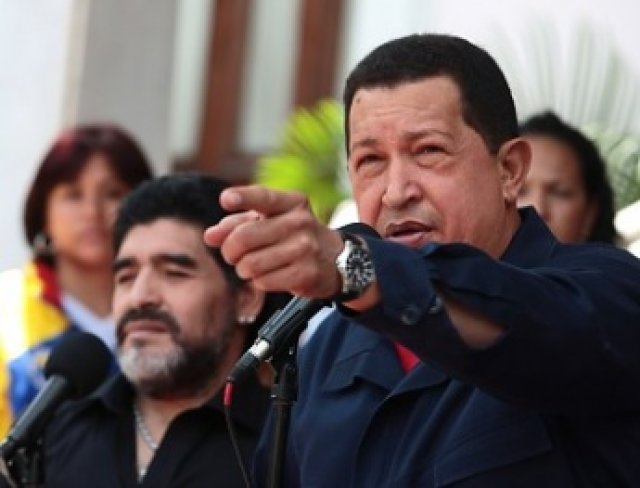
Venezuelan President Hugo Chavez ordered a maximum alert on Venezuela’s border with Colombia after the administration of Colombian President Alvaro Uribe accused the Chavez government of harbouring terrorists and running terrorist training camps on July 22.
Uribe’s government gave a shameful presentation before member states of the Organisation of American States (OAS) on July 22. It was similar to former US Secretary of State Colin Powell’s 2003 “weapons of mass destruction” Power Point evidence to the United Nations Security Council to justify the war in Iraq.
Colombia alleged that Venezuela was harbouring “terrorists” from the Armed Revolutionary Forces of Colombia (FARC) and the National Liberation Army (ELN), and hosting several “terrorist training camps” near the border region that divides the two nations.
During an extraordinary session convened at OAS headquarters in Washington on July 22, Colombia’s ambassador to the OAS, Luis Alfonso Hoyos, presented television and video images allegedly taken from computers confiscated during the illegal invasion of Ecuadorian territory in March 2008. FARC leader Raul Reyes and a dozen other Colombian, Ecuadorian and Mexican citizens were killed as a result.
Hoyos also presented several computer-generated maps and photographs of alleged members of the FARC, which he said were taken inside Venezuela.
None of the images were verified by any source other than the Colombian government. Colombia also used satellite map images, some from Google Earth, to show alleged “coordinates” where FARC members were in Venezuela.
The photographs presented by Hoyos had no source identification, dates or times, and merely showed alleged members of the FARC and ELN in different jungle and coastal areas.
Venezuela and Colombia have similar vegetations, climates and scenery.
Venezuela’s ambassador to the OAS, Roy Chaderton, said the photographs looked to him as though they had been taken in Colombia. “That looks like the beach in Santa Marta to me”, Chaderton said, after Hoyos said a photo of a FARC member drinking a beer on the beach was taken at Chichirivichi, a Venezuelan beach town.
“There is no evidence, not a single piece of proof, of where those photographs were taken”, said Chaderton.
The Venezuelan army inspected the locations provided by the Colombia and found none of the alleged “terrorist sites”, “camps” or “guerrilla presence” claimed by Colombia.
Hoyos called for “international intervention” in Venezuela to verify the campsites and gave Venezuela a “30-day ultimatum” although he didn’t specify what could happen afterward.
“Colombia requests a commission of international members, including all those of the OAS, go to Venezuela and verify each of the terrorist campsites and coordinates to see the truth”, he said.
Hoyos also accused the Venezuelan government of facilitating drug trafficking, money laundering, illegal arms trade, attacks against Colombian armed forces and said the Chavez government “squashes its opposition”, “represses freedom of expression”, “insults other governments” and “violates principles of democracy”.
Colombia’s position is an echo of Washington’s, which has accused Venezuela of harbouring and providing refuge to members of the FARC during the past seven years. But the US government has also failed to present any evidence to back such claims, and has made contradictory statements, which appear to confirm the lack of solid proof.
In March, US Southern Command (Southcom) chief General Douglas Fraser said that he had seen no evidence of any links between Venezuela and the FARC. “We have not seen any connections specifically that I can verify where there has been a direct government-to-terrorist connection”, he said.
However, the following day, Fraser contradicted himself before the press, stating, “There is indeed clear and documented historical and ongoing evidence of the linkages between the Government of Venezuela and the FARC.”
Possibly, Fraser was referring to previous governments in Venezuela, such as those of Carlos Andres Perez (1989-1993) or Rafael Caldera (1994-1998), which actually housed an office of the FARC in the presidential palace. President Chavez shut down that office when he entered the presidency in early 1999.
Or maybe Fraser was referring to the specific requests made by two Colombian presidents, Andres Pastrana and Alvaro Uribe, for Chavez to mediate the release of hostages held by the FARC.
Chavez accepted the role as mediator to secure the release of several hostages held by the FARC inside Colombian territory. For that reason only, Chavez met FARC commander Ivan Marquez and assured the release of Clara Rojas and Consuelo Gonzalez in January 2008.
But otherwise, the Venezuelan government has consistently and repeatedly denied any links or support given to the FARC or any other armed, irregular group from Colombia or elsewhere.
After Colombia’s presentation, President Chavez announced a complete rupture in relations.
“It is with tears in my heart that I announce that we will break all relations with Colombia”, he said. “We have no other choice, for our dignity and our sovereignty”.
“I have ordered a maximum alert on our borders. Uribe is a mafioso and a liar, and is capable of anything.”
Chavez said Uribe ordered the invasion of Ecuador’s territory in 2008 and then lied to Ecuadorian President Rafael Correa about what had happened.
Venezuela said Colombia had failed to resolve its internal conflicts, including a 60-year-old civil war that has negatively impacted its neighbours with violence and drug trafficking spilling over the borders. More than 4 million Colombians have fled the violence in their country and now live in Venezuela.
The Colombian “show” looks like an effort to justify a pre-emptive war against Venezuela. Last year, Colombia allowed seven US military bases in its borders in an agreement that the US Air Force claimed was necessary to conduct “full spectrum military operations” throughout South America to “combat the constant threat of anti-American governments in the region”.
[Reprinted from Eva Golinger’s blog.]